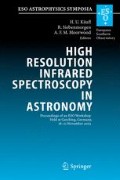Abstract
High resolution spectroscopy is the key method to scrutinize stellar surface properties. With the advent of large telescopes high resolution/high SNR spectra can be obtained unveiling spectral details even in relatively slowly rotating stars. Data quality allows to identify broadening mechanisms or spectral signatures that are particularly interesting in infrared lines. In principal, isolated lines showing undisturbed broadening patterns are required to study broadening mechanisms but are hardly available especially in the crowded spectra of cool stars. On the other hand, Doppler broadening has the same characteristic fingerprint in each line, and the information on global broadening can simultaneously be collected from all spectral lines. Deconvolution techniques reconstruct the global broadening pattern from as many lines as possible. Utilizing a carefully chosen unbroadened template spectrum, the deconvolution process effectively deblends all spectral lines, isolates the global broadening pattern by averaging out line specific features, and boosts the SNR of the constructed “overall” profile. One critical point is the choice of the template spectrum; with a technique performing iterative profile and template optimization even the details of high quality spectra has been reconstructed with high accuracy and robustness. Optimizing both, template and broadening function, Least Squares Deconvolution (LSD) offers the possibility to (i) study global broadening mechanisms (e.g., stellar rotation laws); (ii) derive equivalent widths in large wavelength regions; and (iii) individually study the shape of each (deblended) line. Recently, applying LSD the subtle signatures of stellar differential rotation were uncovered in a number of stars, and a variety of applications can benefit from the advantages of this technique, namely studies on surface convection and line formation, Zeeman splitting, line databases etc.
Preview
Unable to display preview. Download preview PDF.
Author information
Authors and Affiliations
Editor information
Rights and permissions
About this paper
Cite this paper
Reiners, A. Don’t Waste a Single Photon – The Power of Deconvolution in High Resolution Spectroscopy. In: Käufl, H.U., Siebenmorgen, R., Moorwood, A.F.M. (eds) High Resolution Infrared Spectroscopy in Astronomy. ESO Astrophysics Symposia. Springer, Berlin, Heidelberg. https://doi.org/10.1007/10995082_10
Download citation
DOI: https://doi.org/10.1007/10995082_10
Published:
Publisher Name: Springer, Berlin, Heidelberg
Print ISBN: 978-3-540-25256-6
Online ISBN: 978-3-540-31606-0
eBook Packages: Physics and AstronomyPhysics and Astronomy (R0)

